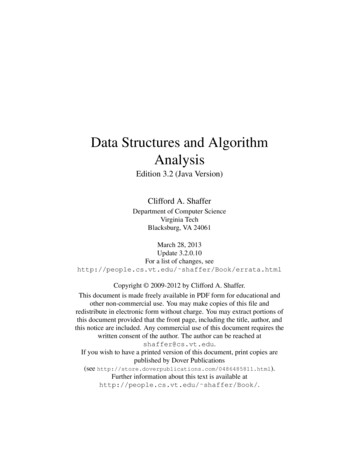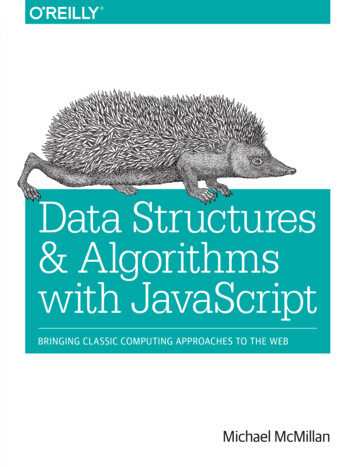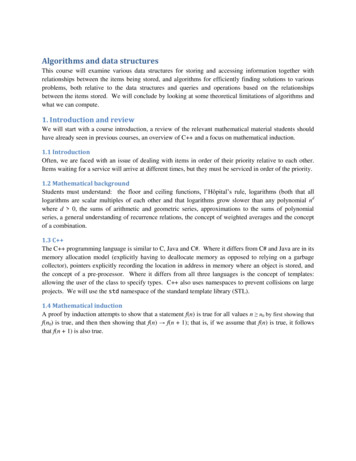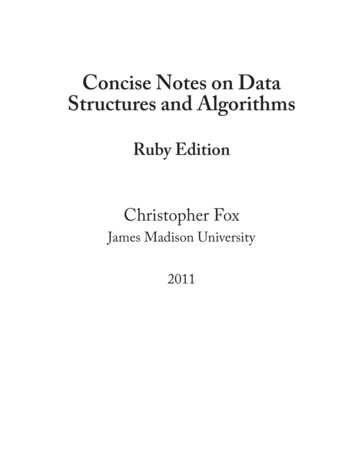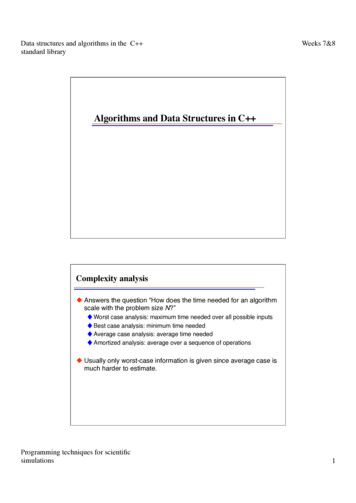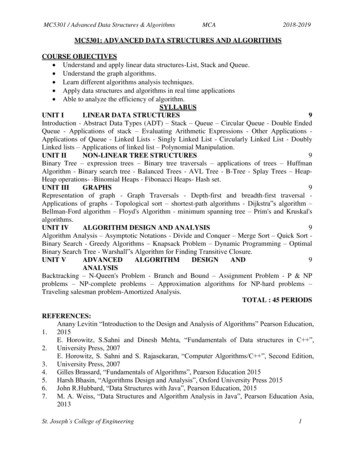
Transcription
MC5301 / Advanced Data Structures & AlgorithmsMCA2018-2019MC5301: ADVANCED DATA STRUCTURES AND ALGORITHMSCOURSE OBJECTIVES Understand and apply linear data structures-List, Stack and Queue. Understand the graph algorithms. Learn different algorithms analysis techniques. Apply data structures and algorithms in real time applications Able to analyze the efficiency of algorithm.SYLLABUSUNIT ILINEAR DATA STRUCTURES9Introduction - Abstract Data Types (ADT) – Stack – Queue – Circular Queue - Double EndedQueue - Applications of stack – Evaluating Arithmetic Expressions - Other Applications Applications of Queue - Linked Lists - Singly Linked List - Circularly Linked List - DoublyLinked lists – Applications of linked list – Polynomial Manipulation.9UNIT IINON-LINEAR TREE STRUCTURESBinary Tree – expression trees – Binary tree traversals – applications of trees – HuffmanAlgorithm - Binary search tree - Balanced Trees - AVL Tree - B-Tree - Splay Trees – HeapHeap operations- -Binomial Heaps - Fibonacci Heaps- Hash set.9UNIT IIIGRAPHSRepresentation of graph - Graph Traversals - Depth-first and breadth-first traversal Applications of graphs - Topological sort – shortest-path algorithms - Dijkstra‟s algorithm –Bellman-Ford algorithm – Floyd's Algorithm - minimum spanning tree – Prim's and Kruskal'salgorithms.9UNIT IVALGORITHM DESIGN AND ANALYSISAlgorithm Analysis – Asymptotic Notations - Divide and Conquer – Merge Sort – Quick Sort Binary Search - Greedy Algorithms – Knapsack Problem – Dynamic Programming – OptimalBinary Search Tree - Warshall‟s Algorithm for Finding Transitive Closure.9UNIT VADVANCEDALGORITHMDESIGNANDANALYSISBacktracking – N-Queen's Problem - Branch and Bound – Assignment Problem - P & NPproblems – NP-complete problems – Approximation algorithms for NP-hard problems –Traveling salesman problem-Amortized Analysis.TOTAL : 45 PERIODSREFERENCES:Anany Levitin “Introduction to the Design and Analysis of Algorithms” Pearson Education,1. 2015E. Horowitz, S.Sahni and Dinesh Mehta, “Fundamentals of Data structures in C ”,2. University Press, 2007E. Horowitz, S. Sahni and S. Rajasekaran, “Computer Algorithms/C ”, Second Edition,3. University Press, 20074. Gilles Brassard, “Fundamentals of Algorithms”, Pearson Education 20155. Harsh Bhasin, “Algorithms Design and Analysis”, Oxford University Press 20156. John R.Hubbard, “Data Structures with Java”, Pearson Education, 20157. M. A. Weiss, “Data Structures and Algorithm Analysis in Java”, Pearson Education Asia,2013St. Joseph’s College of Engineering1
MC5301 / Advanced Data Structures & AlgorithmsMCA2018-2019Peter Drake, “Data Structures and Algorithms in Java”, Pearson Education 2014T. H. Cormen, C. E. Leiserson, R. L. Rivest, and C. Stein, "Introduction to algorithms",Thrid Edition, PHI Learning Private Ltd, 201210. Tanaenbaum A.S.,Langram Y. Augestein M.J, “Data Structures using C” PearsonEducation , 2004.11. V. Aho, J. E. Hopcroft, and J. D. Ullman, “Data Structures and Algorithms”, PearsonEducation, 1983COURSE OUTCOMES (COs)C201.1: Describe, explain and use abstract data types including stacks, queues and listsC201.2: Design and Implement Tree data structures and SetsC201.3: Able to understand and implement non linear data structures - graphsC201.4: Able to understand various algorithm design and NG BETWEEN COs, POs AND PSOsPROGRAMME OUTCOMES (POs)PSOsPO1 P02 PO3 PO4 PO5 PO6 PO7 PO8 PO9 PO10 PO11 PO12 PSO1 ELATION BETWEEN COURSE CONTENTS WITH CO’sKnowledgeCourseS.NoCOURSE CONTENTlevelOutcomesUNIT ILINEAR DATA STRUCTURES 9 hrs1U,RIntroduction - Abstract Data Types (ADT)2U, An,AP,C Stack – Queue – Circular Queue - Ended Queue3U, An, ApApplications of stack4U, An, ApEvaluating Arithmetic ExpressionsC201.15An, Ap, EApplications of Queue - Linked Lists - SinglyLinked List - Circularly Linked List - DoublyLinked lists6U, Ap, E, C Applications of linked list7U, An,AP,C Polynomial ManipulationUNIT IINON-LINEAR TREE STRUCTURES - 9hrs1U, An,AP,C Binary Tree – expression trees – Binary treetraversals2U, An, ApApplications of trees3U, R, CHuffman Algorithm4U, Ap, CBinary search tree - Balanced TreesC201.25U, Ap, AnAVL Tree - B-Tree - Splay Trees6U, Ap, C, E Heap- Heap operations- -Binomial Heaps Fibonacci Heaps7U,RHash setSt. Joseph’s College of Engineering2
MC5301 / Advanced Data Structures & AlgorithmsMCA2018-2019UNIT III1U, C2U, ApGRAPHS- 9 hrsRepresentation of graphGraph Traversals - Depth-first and breadth-firsttraversal3U, Ap, E, C Applications of graphs4U, Ap, CTopological sortC201.35U, Ap, E, C shortest-path algorithms - Dijkstra‟s algorithm –Bellman-Ford algorithm – Floyd's Algorithm6U, Ap, E, C Minimum Spanning Tree7U, Ap, E, C Prim's and Kruskal's Algorithms.UNIT IVALGORITHM DESIGN AND ANALYSIS - 9 hrs1U,Ap, An, E Algorithm Analysis – Asymptotic Notations2U, Ap, RDivide and Conquer – Merge Sort – Quick Sort3U, Ap, C, E Binary Search4U,Ap, An, E Greedy Algorithms – Knapsack ProblemC201.45U,Ap, An, E Dynamic Programming6U,Ap, An, E Optimal Binary Search Tree7U,Ap, An, E Warshall‟s Algorithm for Finding TransitiveClosureUNIT VADVANCED ALGORITHM DESIGN AND ANALYSIS - 9 hrs1U,Ap, An, E Backtracking2U,Ap, An, E N-Queen's Problem3U,Ap, An, E Branch and Bound4U,Ap, An, E Assignment ProblemC201.45U,Ap, An, E P & NP problems – NP-complete problems Approximation algorithms for NP-hard problems6U,Ap, An, E Traveling salesman problem6U,Ap, An, E Amortized AnalysisADDITIONAL TOPICSThe Knight Problem using backtrackingC201.4Finding a Hamiltonian circuit or disprove its existence in the graphC201.3R – Remember; Ap – Apply; An – Analyze; U – Understand, E- Evaluate ,C-CreatePART - AUNIT – I1. Define data structure. What is the main advantage of data structure?A data structure is a logical or mathematical way of organizing data. It is the way oforganizing, storing and retrieving data and the set of operations that can be performed onthat data.Eg.: Arrays, structures, stack, queue, linked list, trees, graphs.2. What are the different types of data structures.Primitive Data Structure- It is basic data structure which is defined by the language andcan be accessed directly by the computer.St. Joseph’s College of Engineering3
MC5301 / Advanced Data Structures & AlgorithmsMCA2018-2019Non Primitive Data Structure- Data structure emphasize on structuring of a group ofhomogenous or heterogeneous data item.Linear Data Structure- A data structure which contains a linear arrangement ofelements in the memory.Non-Linear Data Structure- A data structure which represents a hierarchicalarrangement of elements.3. Define Abstract Data Type.An Abstract data type is a data type that is organized in such a way that thespecification ofthe objects and the specification of operations on the objects isseparated from the representation of the objects and the implementation of theoperations. In other words, ADT is a collection of values and a set of operations on thosevalues. ADT is a mathematical toolfor specifying the logical properties of a datatype.4. Define an array. Mention the different kinds of arrays with which you canmanipulate and represent data.An array is a group of related data items that shares a common name. In other words, wecan say it is a collection of data items which are of same data type. The data items arestored in contiguous memory locations. There are three kinds of arrays present for themanipulation and representation of data.They are1. One dimensional array.2. Two dimentional array.3. Multi dimentional array.5. A two dimensional array consisting of 8 rows and 3 columns is stored in a rowmajor order. Compute the address of element A(4, 2). Base address is 1000 andword length is 2. Find the address of the same element in the column majorrepresentation.In Row major representationAddress(a[i, j]) base address [ (i-l1) * (u2-l2 1) (j-l2) ] * element sizeHere we can represent the array as a[0.7, 0.2]Base address 1000l1 0, u1 7, l2 0, u2 2I 4, j 2Element size 2Address(a[4,2]) 1000 [(4-0)*(2-0 1) (2-0)] * 2 1000 [ 4*3 2] *2 1028In Column major representationAddress(a[i, j]) base address [ (j-l2) * (u1-l1 1) (i-l1) ] * element sizeHere we can represent the array as a[0.7, 0.2]Base address 1000L1 0, u1 7, l2 0, u2 2I 4, j 2Element size 2Address(a[4,2]) 1000 [ (2-0) * (7-0 1) (4-0) ] * 2 1000 [ 2 * 8 4 ] *2 1040St. Joseph’s College of Engineering4
MC5301 / Advanced Data Structures & AlgorithmsMCA2018-20196. How much memory is required for storing two matrices A(10,15,20) and B(11,16,21)where each element requires 16 bit for storage.Number of elements in array A 10*15*20 3000Element Size 16 bits.Memory required for storing A 3000*16 48,000Number of elements in array A 11*16*21 3696Element Size 16 bitsMemory Required for storing A 3696 *16 59,136Total 107136 bits 107136/8 13,392 bytes.7. What are the differences between arrays and structures? (JAN 2012)ARRAYSSTRUCTURES1.Array size should be mentioned during Declared using the keyword “struct”.the declaration.2. Array uses static memory location.Each member has its own memorylocation.3. Each array element has only one part.Only one member can be handled at atime.8. Define stack. Give some applications of stack.A stack is an ordered list in which insertions and deletions are made at one end called thetop. Stack is called as a Last In First Out(LIFO) data structure. Stack is used in Functioncall, Recursion and evaluation of expression.9. How do you check the stack full and stack empty condition?Void StackFull(){If (top maxsize-1)Printf(“Stack is Full”);}Void StackEmpty(){If (top -1)Printf(“Stack is Empty”);}10. Define the terms: Infix, postfx and prefix. INFIX: It is a conventional way of writing an expression.The notation is Operand Operator Operand This is called infix because the operators are in between the operands.EXAMPLE: A B POSTFIX: In this notation the operator is suffixed by operands. Operand Operand Operator EXAMPLE: AB PREFIX: In this notation the operator preceeds the two operands. Operator Operands Operand EXAMPLE: ABSt. Joseph’s College of Engineering5
MC5301 / Advanced Data Structures & AlgorithmsMCA2018-201911. What are the advantages in reverse polish (prefix and postfix notation) over polish(infix) notation?The advantages in prefix & postfix notation over infix notation is:The scanning of the expression is required in only one direction viz. from left toright and only once; where as for the infix expression the scanning has to be done in bothdirections.For example, to evaluate the postfix expression abc* , we scan from left to rightuntil we encounter *. The two operands which appear immediately to the left of thisoperator are its operands and the expression bc* is replaced by its value.12. Define queue and give its applicationsA Queue is an ordered list in which all insertions take place at one end called the rear andall deletions take place at the opposite end called the front. The Queue is called as theFIFO data structure.Applications of Queue:1. It is used in batch processing of O.S2. It is used in simulation3. It is used in queuing theory4. It is used in computer networks where the server takes the jobs of the clientsusing queuing strategy.13. What is a circular queue? How do you check the queue full condition?In circular queue, the elements are arranged in a circular fashion. Circular queue is a datastructure which efficiently utilizes the memory space & the elements Q[0], Q[1], , Q[n1] are arranged in circular fashion such that Q[n-1] is followed by Q[0].It returns queue full condition only when the queue does not have any space to insert newvalues. But ordinary queue returns queue full condition when the rear reaches the lastposition.Void CircularQFull(){if (front (rear 1)%maxsize)printf(“Circular Queue is Full”);}14. Write an algorithm to count the nodes in a circular queueint countcq(){Count 0;If (front -1)Printf (“ Queue is empty”);Else{i frontwhile (i ! rear){Count ;i (i 1)%maxsize;}Count ;St. Joseph’s College of Engineering6
MC5301 / Advanced Data Structures & AlgorithmsMCA2018-2019}Return(count);}15. Define Dequeue.Dequeue is a queue in which insertion and deletion can happen in both the ends(front & rear) of the queue.Insertion1020Insertion30DeletionDeletion16. What are the two kinds of dequeue?Input restricted dequeue -- restricts the insertion of elements at one end (rear) only, butthe deletion of elements can be done at both the ends of a queue.Output restricted dequeue --Restricts the deletion of elements at one end (front) only,and allows insertion to be done at both the ends of a deque.17. What is a priority queue?A queue in which we are able to insert or remove items from any position based on somepriority is referred to as priority queue.18. Define Linked list and give its applications.It is an ordered collection of homogeneous data elements. The elements of the linked listare stored in non contiguous memory locations. So each element contains the address ofthe next element in the list. The last node contains the NULL pointer which represents theend of the list.Example:First16410NULLApplications of Linked List: It is used in polynomial manipulation. It is used for sparse matrix representation.19. Compare array and linked list.ArrayLinked List1. In an array, the successive elements are 1. Successive elements in the list can bein contiguous memory locationsstored any where in the memory2. Insertion & deletion operation requires 2. No data movement during insertion &lot of data movement.deletion.3. The amount of memory needed to store 3. More storage is needed because withthe list is less.each data item the link is also stored.4. Follows static memory allocation4. Follows dynamic memory allocation.20. Define Doubly Linked List.The Doubly linked list is a collection of nodes each of which consists of three partsnamely the data part, prev pointer and the next pointer. The data part stores the value ofthe element, the prev pointer has the address of the previous node and the next pointerhas the value of the next node.St. Joseph’s College of Engineering7
MC5301 / Advanced Data Structures & AlgorithmsMCA2018-2019In a doubly linked list, the head always points to the first node. The prev pointer of thefirst node points to NULL and the next pointer of the last node points to NULL.21. What are the advantages of using doubly linked list over singly linked list?The advantage of using doubly linked list is,it uses the double set of pointers.Onepointing to the next item and other pointing to the preceeding item.This allows us totraverse the list in either direction.22. List the advantages of linked listSince linked list follows dynamic memory allocation, the list can growdynamically, the insertion and deletion of elements into the list requires no datamovementUNIT-II1. Define tree.A tree is a finite set of one or more nodes such that there is a specially designated nodecalled the root. The remaining nodes are partitioned into n 0 disjoint sets T1, T2, ,Tn, where each of these sets is a tree. T1, ,Tn are called the subtrees of the root.2. Define the following terms: node, leaf node, ancestors, siblings of a nodeNode: Each element of a binary tree is called node of a tree. Each node may be a root of atree with zero or more sub trees.Leaf node: A node with no children (successor) is called leaf node or terminal node.Ancestor: Node n1 is an ancestor of node n2 if n1 is either a father of n2 or father ofsome ancestor of n2.Siblings: Two nodes are siblings if they are the children of the same parent.3. Define level of a node, degree of a node, degree of a tree, height and depth of a tree.Level of a node: The root node is at level 1. If a node is at level l, then its children are atlevel i 1.Degree of a node: The number of sub trees of a node is called as degree of a node.The degree of a tree is the maximum of the degree of the nodes in the tree.The height or depth of a tree is defined to be the maximum level of any node in the tree.4. What are the ways to represent Binary trees in memory?1. Array representation (or) Sequential Representation.2. Linked List representation (or) Node representation.5. Define binary tree.Binary tree is a finite set of elements that is either empty or is partitioned into threedisjoint subsets. The first subset contains the single element called the root of tree. Theother two subsets are themselves binary tree called the left and right sub tree of originaltree. In other words, a binary tree is a tree in which each node can have a maximum oftwo children.6. Define Full binary tree (or) Complete binary treeA full binary tree of depth k is a binary tree of depth k having 2k – 1 nodes. In other words,all the levels in the binary tree should contain the maximum number of nodes.St. Joseph’s College of Engineering8
MC5301 / Advanced Data Structures & AlgorithmsMCA2018-20197. Define strictly binary treeIf every non leaf node in a binary tree has non empty left and right sub trees then the tree istermed as strictly binary tree. In other words, a strictly binary tree contains leaf nodes and nonleaf nodes of degree8. List out few of the Application of tree data-structure?The applications of tree data-structure are the manipulation of Arithmetic expression, SymbolTable construction, Syntax analysis.9. Define expression treeAn expression tree is built up from the simple operands and operators of an(arithmetic orlogical) expression by placing the simple operands as the leaves of a binary tree and theoperators as the interior nodes.10. Traverse the given tree using Inorder, Preorder and Postorder traversals.Given tree:ACBDEH Inorder : Preorder: Postorder:GFIJDHBEAFCIGJABDHECFGIJHDEBFIJGCA11. How many null branches can a binary tree have with 20 node?21 null branchesLet us take a tree with 5 nodes (n 5)Null BranchesIt will have only 6 (ie,5 1) null branches. In general, a binary tree with n nodes hasexactly n 1 null node. Thus a binary tree with 20 nodes will have 21 null branches.12. What is a binary search tree?A binary search tree is a binary tree. It may be empty. If it is not empty then, it satisfies thefollowing properties.St. Joseph’s College of Engineering9
MC5301 / Advanced Data Structures & AlgorithmsMCA2018-20191. Every element has a key & the keys are distinct.2. The keys in the left sub tree is smaller than the key in the root.3. Keys in the right sub tree is larger than the key in the root.4. The left & right sub trees are also BST.13. How will you construct binary search tree?a. Make the first node as the root node.b. To insert the next node into the BST, search for the value in the BST. If the value isfound in the BST, then a duplicate value cannot be inserted into the BST.c. If the element is not found, add the element at the point where the search becomesunsuccessful.14. Define the term skewed tree?In skewed tree all the nodes are skewed in one direction either left or right.Left Skewed Tree: A tree in which all nodes are skewed in left direction.Right Skewed Tree: A tree in which all nodes are skewed in right direction.15. What is the maximum number of nodes in level i of a binary tree and what is themaximum number of nodes in a binary tree of depth k?The maximum number of nodes in level i of a binary tree 2i-1The maximum number of nodes in a binary tree of depth k 2k-1, where k 016.What are the non-linear data structures?(JAN 2014)Non-Linear Data Structure- A data structure which represents a hierarchical arrangement ofelements. Examples: Graphs and trees.17. Define balanced search tree.Balanced search tree have the structure of binary tree and obey binary search tree propertieswith that it always maintains the height as O(log n) by means of a special kind of rotations.Eg. AVL, Splay, B-tree.18.What are the drawbacks of AVL trees?The drawbacks of AVL trees are Frequent rotations The need to maintain balances for the tree’s nodes Overall complexity, especially of the deletion operation.19. Define B-tree?A B-tree of order m in an m-way search tree that is either empty or is of height 1 and1. The root node has at least 2 children2. All nodes other than the root node and failure nodes have at least m/2 children.3. All failure nodes are at same level.20. Explain AVL rotation.Manipulation of tree pointers is centered at the pivot node to bring the tree back into heightbalance. The visual effect of this pointer manipulation so to rotate the sub tree whose root isthe pivot node. This operation is referred as AVL rotation.21. What are the different types of Rotation in AVL Tree?Two types of rotation are1. single rotation2. double rotation.22. Explain Hashing.Hashing is a technique used to identify the location of an identifier ‘x’ in the memory bysome arithmetic functions like f(x), which gives address of ‘x’ in the table.St. Joseph’s College of Engineering10
MC5301 / Advanced Data Structures & AlgorithmsMCA2018-201923. Explain Hash Function. Mention Different types of popular hash function.Hash Function takes an identifier and computes the address of that identifier in the hash table.1.Division method2.Square method3.Folding method24.Define Splay Tree.A splay tree is a self-adjusting binary search treewith the additional property that recentlyaccessed elements are quick to access again. It performs basic operations such as insertion,look-up and removal in O(log n) amortized time.25. What are the different rotations in splay tree? Zig Rotation. Zag Rotation Zig-Zag Rotation. Zag-Zig Rotation Zig-Zig Rotation Zag-Zag- Rotation26.Write short notes on Heap.Heap is a special case of balanced binary tree data structure where the root-node key is comparedwith its children and arranged accordingly. If α has child node β then key(α) key(β)27.Define Binomial Heap.A Binomial Heap is a collection of Binomial Trees A Binomial Tree of order 0 has 1 node. ABinomial Tree of order k can be constructed by taking two binomial trees of order k-1, andmaking one as leftmost child of other.A Binomial Tree of order k has following properties.a) It has exactly 2k nodes.b) It has depth as k.c) There are exactly kCi nodes at depth i for i 0, 1, . . . , k.d) The root has degree k and children of root are themselves Binomial Trees with order k-1, k2,. 0 from left to right.28.Define Fibonacci Heaps.Fibonacci heap is a data structure for priority queue operations, consisting of a collectionof heap-ordered trees. It has a better amortized running time than many other priority queue datastructures including the binary heap and binomialheap.29.Write notes on Hash Set. Implements Set Interface. Underlying data structure for HashSet is hashtable. As it implements the Set Interface, duplicate values are not allowed. Objects that you insert in HashSet are not guaranteed to be inserted in same order. Objects are inserted based on their hash code. NULL elements are allowed in HashSet. HashSet also implements Searlizable and Cloneable interfaces.St. Joseph’s College of Engineering11
MC5301 / Advanced Data Structures & AlgorithmsMCA2018-2019UNIT-III1. Write the concept of Prim’s spanning tree.Prim’s algorithm constructs a minimum spanning tree through a sequence of expandingsub trees. The initial sub tree in such a sequence consists of a single vertex es.On each iteration, we expand the current tree in the greedy manner by simply attaching toit the nearest vertex not in that tree. The algorithm stops after all the graph’s vertices havebeen included in the tree being constructed2. What is the purpose of Dijikstra’s Algorithm?Dijikstra’s algorithm is used to find the shortest path between sources to every vertex.This algorithm is applicable to undirected and directed graphs with nonnegative weightsonly.3. How efficient is prim’s algorithm?It depends on the data structures chosen for the graph itself and for the priority queue ofthe set V-VT whose vertex priorities are the distances to the nearest tree vertices.4. Mention the two classic algorithms for the minimum spanning tree problem. Prim’s algorithm Kruskal’s algorithm5. What is the Purpose of the Floyd algorithm?The Floyd’s algorithm is used to find the shortest distance between every pair of verticesin a graph.6. What are the conditions involved in the Floyd’s algorithm? Construct the adjacency matrix. Set the diagonal elements to zero Ak[i,j] min Ak-1[i,j]Ak-1[i,k]and Ak-1[k,j]7. Write the concept of kruskal’s algorithm.Kruskal’s algorithm looks at a minimum spanning tree for a weighted connected graphG (V,E) as an acyclic sub graph with V -1 edges for which the sum of the edge weightsis the smallest. Consequently, the algorithm constructs a minimum spanning tree as anexpanding sequence of sub graphs, which are always acyclic but are not necessarilyconnected on the intermediate stages of the algorithm. The algorithm begins by sortingthe graph’s edges in non decreasing order of their weights. Then, starting with the emptysub graph, it scans this sorted list, adding the next edge on the list to the current sub graphif such an inclusion does not create a cycle and simply skipping the edge otherwise.8. What is the difference between dynamic programming with divide and conquermethod?Divide and conquer divides an instance into smaller instances with no intersectionswhereas dynamic programming deals with problems in which smaller instances overlap.Consequently divide and conquer algorithm do not explicitly store solutions to smallerinstances and dynamic programming algorithms do.9. State two obstacles for constructing minimum spanning tree using exhaustivesearch approach. The number spanning tree grows exponentially with the graph sizeSt. Joseph’s College of Engineering12
MC5301 / Advanced Data Structures & AlgorithmsMCA2018-2019 Generating all spanning trees for a given graph is not easy; in fact, it ismore difficult than finding a minimum spanning tree for a weighted graph byusing one of several efficient algorithms available for this problem10. Define spanning tree and minimum spanning tree problem.A spanning tree of a connected graph is its connected acyclic sub graph that contains allthe vertices of the graph. A minimum spanning tree problem is the problem of finding aminimum spanning tree for a given weighted connected graph.11. Define the single source shortest paths problem.Dijkstra’s algorithm solves the single-source shortest-path problem of finding shortestpaths from a given vertex (the source) to all the other vertices of a weighted graph ordigraph. It works as Prim’s algorithm but compares path lengths rather than edge lengths.Dijkstra’s algorithm always yields a correct solution for a graph with nonnegativeweights12. Mention the methods for generating transitive closure of digraph. Depth First Search (DFS) Breadth First Search (BFS)13. What do you meant by graph traversals?Graph traversal (also known asgraph search) refers to the process of visiting (checkingand/or updating) each vertex in a graph. Such traversalsare classified by the order inwhich the vertices are visited. Tree traversal is a special case of graph traversal14. Define Depth First Search DFSDepth First Search (DFS) algorithm traverses a graph in a depthward motion and uses a stackto remember to get the next vertex to start a search, when a dead end occurs in any iteration.15. Write down the steps involved in DFSRule 1 Visit the adjacent unvisited vertex. Mark it as visited. Display it. Push it in astack.Rule 2 If no adjacent vertex is found, pop up a vertex from the stack. (It will pop up allthe vertices from the stack, which do not have adjacent vertices.)Rule 3 Repeat Rule 1 and Rule 2 until the stack is empty16. Define Breadth First Search (BFS)Breadth First Search (BFS) algorithm traverses a graph in a breadthward motion and usesa queue to remember to get the next vertex to start a search, when a dead end occurs inany iteration.17. Write down the steps involved in Breadth First Search (BFS)Rule 1 Visit the adjacent unvisited vertex. Mark it as visited. Display it. Insertit in a queue.Rule 2 If no adjacent vertex is found, remove the first vertex from the queue.Rule 3 Repeat Rule 1 and Rule 2 until the queue is empty18. Define graph data structureA graph is a pictorial representation of a set of objects where some pairs of objects areconnected by links. The interconnected objects are represented by points termedas vertices, and the links that connect the vertices are called edges. Formally, a graph is apair of sets (V, E), where V is the set of vertices and Eis the set of edges, connecting thepairs of vertices.St. Joseph’s College of Engineering13
MC5301 / Advanced Data Structures & AlgorithmsMCA2018-201919. Define topological sortingTopological sorting of vertices of a Directed Acyclic Graph is an ordering of thevertices v1,v2,.vn in such a way, that if there is an edge directed towards vertex vj fromvertex vi, then vi comes before vj.20. Define Memory function techniquesThe memory function technique seeks to combine strengths of the top-down andbottom-up approaches to solving problems with overlapping sub problems. It does thisby solving, in the top-down fashion but only once, just necessary sub problems of agiven problem and recording their solutions in a table.UNIT-IV1. Define Algorithm.An algorithm is a sequence of unambiguous instructions for solving a problem, i.e., forobtaining a required output for any legitimate input in a finite amount of time.2. Define order of an algorithm.The order of an algorithm is a standard notation of an algorithm that has been developedto represent function that bound the computing time for algorithms. The order of analgorithm is a way of defining its efficiency. It is usually referred as Big O notation.3. What are the f
John R.Hubbard, “Data Structures with Java”, Pearson Education, 2015 7. M. A. Weiss, “Data Structures and Algorithm Analysis in Java”, Pearson Education Asia, 2013 . MC5301 / Advanced Data Structures & Algorit
